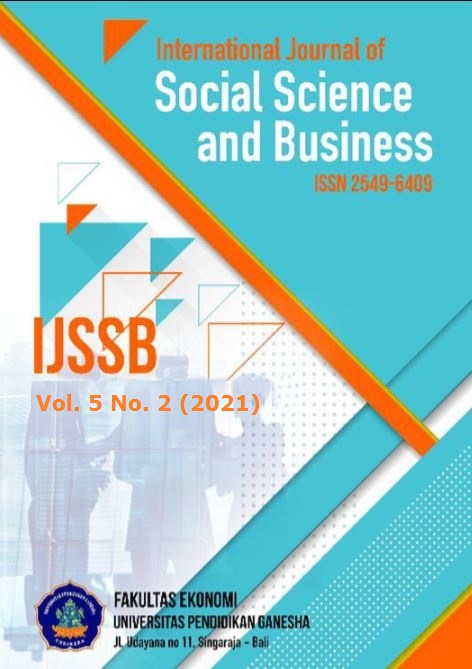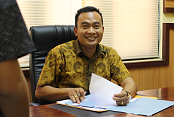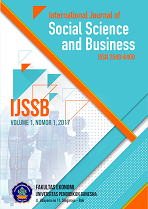Emina Girl Gang Ambassador (EGGA) As A Public Relations Marketing Strategy in Building Emina Cosmetic’s Brand Image
DOI:
https://doi.org/10.23887/ijssb.v5i2.33274Keywords:
marketing public relations, brand image, strategy, roles, peer groupsAbstract
Cosmetics are ingredients that are used to support one's appearance and at the same time have a good impact on the health of the human body. Nowadays, cosmetics are not only used for aesthetic effect, they also increase self-confidence and look more attractive. The steadily increasing growth of the local cosmetics business sector in Indonesia has become a subject of attention for PT Paragon Technology and Innovation which is a cosmetics company that owns three main brands: Make Over, Wardah and Emina Cosmetic. In this study, the researcher intends to discuss in depth Emina of PT paragon through the best strategy to maintain a firm presence in the competitive business of local cosmetics. Certainly, Effective and creative strategies are. Without a doubt, needed so that the company can compete on attracting public attention, one of these strategies is the application of Emina Girl Gang Ambassador (EGGA) as a Public Relations Marketing strategy in the company. Through this study, the researcher intends to determine and analyze the role of Emina Girl Gang Ambassador in 7 Marketing Public Relations tools by Kotler and Keller. This study used a descriptive qualitative method with data collection techniques of semi-structured interviews and data reduction analysis techniques by Miles and Huberman. The results showed that Emina's brand from PT Paragon Technology and Innovation used 2 main tools from 7 points presented by Kotler and Keller, namely events and sponsors.
References
Arora, A., Bansal, S., Kandpal, C., Aswani, R., & Dwivedi, Y. (2019). Measuring social media influencer index-insights from Facebook, Twitter and Instagram. Journal of Retailing and Consumer Services, 49, 86–101. https://doi.org/10.1016/j.jretconser.2019.03.012.
Casaló, L. V, Flavián, C., & Ibáñez-Sánchez, S. (2018). Influencers on Instagram: Antecedents and consequences of opinion leadership. Journal of Business Research. https://doi.org/10.1016/j.jbusres.2018.07.005.
Childers, C. C., Lemon, L. L., & Hoy, M. G. (2019). Agency perspective on influencer marketing campaigns. Journal of Current Issues & Research in Advertising, 40(3), 258–274. https://doi.org/10.1080/10641734.2018.1521113.
Chine, B C, Bernard, C. C., Chiamaka, O., & Udeze, C. (2019). Peer Influence And Product Advertisement As Predictors Of Smartphone Consumer Buying Behaviour. Global Journal of Management and Social Sciences (GOJAMSS), 16, 228–238.
Chine, Bernard Chukwukeluo, Nnedum, A. U., & Ike, P. (2018). Product Packaging And Advertising As Correlates Of Consumer Buying Behaviour In Awka Urban, Anambra State, Nigeria. International Journal of Health and Social Inquiry, 4(1).
Destisya, J., Hendarso, Y., & Yusnaini, Y. (2019). Peran Peer Group Dalam Membentuk Perilaku Konsumtif Mahasiswa Fakultas Ekonomi, Universitas Sriwijaya. Jurnal Sosiologi Nusantara, 5(2), 126–139. https://doi.org/10.33369/jsn.5.2.126-139.
Djafarova, E., & Rushworth, C. (2017). Exploring the credibility of online celebrities’ Instagram profiles in influencing the purchase decisions of young female users. Computers in Human Behavior, 68, 1–7. https://doi.org/:10.1016/j.chb.2016.11.009.
Ismail, A. R. (2017). The influence of perceived social media marketing activities on brand loyalty: The mediation effect of brand and value consciousness. Asia Pacific Journal of Marketing and Logistics, 29(1), 129–144. https://doi.org/10.1108/APJML-10-2015-0154.
Jafferany, M., Salimi, S., Mkhoyan, R., Kalashnikova, N., Sadoughifar, R., & Jorgaqi, E. (2020). Psychological aspects of aesthetic and cosmetic surgery: Clinical and therapeutic implications. Dermatologic Therapy, 33(4), e13727. https://doi.org/10.1111/dth.13727.
Jiménez-Castillo, D., & Sánchez-Fernández, R. (2019). The role of digital influencers in brand recommendation: Examining their impact on engagement, expected value and purchase intention. International Journal of Information Management, 49, 366–376. https://doi.org/10.1016/j.ijinfomgt.2019.07.009.
Kamboj, S., Sarmah, B., Gupta, S., & Dwivedi, Y. (2018). Examining branding co-creation in brand communities on social media: Applying the paradigm of Stimulus-Organism-Response. International Journal of Information Management, 39, 169–185. https://doi.org/10.1016/j.ijinfomgt.2017.12.001.
Kapoor, K. K., Tamilmani, K., Rana, N. P., Patil, P., Dwivedi, Y. K., & Nerur, S. (2018). Advances in social media research: Past, present and future. Information Systems Frontiers, 20(3), 531–558.
Kaur, K., Osman, S., Kaur, S., & Singh, J. (2018). Is Halal a priority in purchasing cosmetics in Malaysia among Muslim Malaysian women. International Journal of Business, Economics and Law, 15(3), 19–25.
Khare, A., Awasthi, G., & Shukla, R. P. (2019). Do mall events affect mall traffic and image? A qualitative study of Indian mall retailers. Asia Pacific Journal of Marketing and Logistics. https://doi.org/10.1108/APJML-01-2019-0021.
Khumaira. (2018). ‘Relationship between Self-Esteem, Body Image, and Peer Support for Consumptive Behavior in Beauty Care Clinic Student Consumers.’
Kusmaharani, A. S., & Halim, R. E. (2020). Social Influence and Online Impulse Buying of Indonesian Indie Cosmetic Products. Jurnal Ilmiah Manajemen, 10(2), 237–248. https://doi.org/10.22441/mix.2020.v10i2.007.
Lou, C., & Yuan, S. (2019). Influencer marketing: how message value and credibility affect consumer trust of branded content on social media. Journal of Interactive Advertising, 19(1), 58–73. https://doi.org/10.1080/15252019.2018.1533501.
Matera, C., Nerini, A., & Stefanile, C. (2018). Why are men interested in cosmetic surgery procedures? Examining the role of different forms of peer influence, social comparison, internalization, and body dissatisfaction. Body Image, 26, 74–77. https://doi.org/10.1016/j.bodyim.2018.06.003.
Nuriasari, S. (2018). Analisa Rasio Likuiditas Dalam Mengukur Kinerja Keuangan PT. Mustika Ratu, Tbk (Tahun 2010-2016). Jurnal Riset Bisnis Dan Investasi, 4(2), 1–9. https://doi.org/10.35697/jrbi.v4i2.1181.
Plumeyer, A., Kottemann, P., Böger, D., & Decker, R. (2019). Measuring brand image: a systematic review, practical guidance, and future research directions. Review of Managerial Science, 13(2), 227–265. https://doi.org/10.1007/s11846-017-0251-2.
Shiau, W.-L., Dwivedi, Y. K., & Lai, H.-H. (2018). Examining the core knowledge on facebook. International Journal of Information Management, 43, 52–63. https://doi.org/10.1016/j.ijinfomgt.2018.06.006.
Sokolova, K., & Kefi, H. (2020). Instagram and YouTube bloggers promote it, why should I buy? How credibility and parasocial interaction influence purchase intentions. Journal of Retailing and Consumer Services, 53. https://doi.org/10.1016/j.jretconser.2019.01.011.
Wacono, T. D., Lukitaningsih, A., & Maharani, B. D. (2021). Pengaruh Electronic Word of Mouth (E-WoM), Kelompok Teman Sebaya (Peer Group) dan Gaya Hidup Hedonis pada Keputusan Pembelian Konsumen Filosofi Kopi Jogja. JBE (Jurnal Bingkai Ekonomi), 6(1), 45–57.
Walker, C. E., Krumhuber, E. G., Dayan, S., & Furnham, A. (2019). Effects of social media use on desire for cosmetic surgery among young women. Current Psychology, 1–10. https://doi.org/10.1007/s12144-019-00282-1.
Widyastuti, R., & Malau, R. M. U. (2020). Pengaruh Komunikasi Kelompok Teman Sebaya (peer Group) Terhadap Keputusan Pembelian Produk Kosmetik Wardah Pada Wanita Usia 20-35 Di Kota Bandung. EProceedings of Management, 7(2).
Wilvestra, S., Lestari, S., & Asri, E. (2018). Retrospective Study of Skin Cancer in the Skin and Gynecology Health Clinic of Rs Dr. M Djamil Padang Period 2015-2017. J Health Andalas., 7(Supplement3), 47–49.
Wiridjati, W., & Roesman, R. R. (2018). Fenomena Penggunaan media sosial dan pengaruh teman sebaya pada generasi milenial terhadap keputusan pembelian. Jurnal Manajemen Dan Pemasaran Jasa, 11(2), 275–290. https://doi.org/10.25105/jmpj.v11i2.2950.
Wu, Y., Alleva, J. M., & Mulkens, S. (2020). Factor Analysis and Psychometric Properties of the Chinese Translation of the Acceptance of Cosmetic Surgery Scale. Body Image, 33, 244–256. https://doi.org/10.1016/j.bodyim.2020.03.009.
Yonita, A. S., Putro, A. S., & Margawati, A. (2019). Determinants of Use of Illegal Skin Care Cosmetics as Triggers Risk of Skin Cancer in Young Women in Nganjuk City. International Journal of Health, Education & Social (IJHES), 2(12), 46–55. https://doi.org/10.1234/ijhes.v2i12.60.











